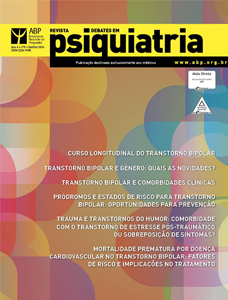Bipolar disorder and gender: what are the news?
DOI:
https://doi.org/10.25118/2236-918X-6-5-2Keywords:
Bipolar disorder, gender, differences, womenAbstract
This article summarizes research published between 2014 and 2016 focusing on differences in clinical care and neurobiology in women and men with bipolar disorder (BD). In BD, female sex correlates with more depressive symptoms and with different comorbidities. Women also present a higher degree of mixed episodes and rapid cycling presentation. Comorbidities, particularly thyroiddisease, obesity, and anxiety disorders occur more frequently in women, while substance use disorders are more common in men. Exercise increases the levels of brain-derived neurotrophic factor in women with BD, but not in men. Male and female patients have distinct biomarkers for BD. Menstrually entrained mood fluctuation is more strongly present in women treated for BD than in healthy controls. Lamotrigine may be of use in mitigating this fluctuation. Lithium-associated thyroid dysregulation occurs more frequently in female patients. Men and women with BD receive different treatments in routine clinical settings. Clinicians’ treatment decisions are, to some extent, unduly influenced by the patient’s gender.
Downloads
Metrics
References
Miller LJ, Ghadiali NY, Larusso EM, Wahlen KJ, Avni-Barron O, Mitt al L, et al. Bipolar disorder in women. Health Care Women Int. 2015;36:475-98. https://doi.org/10.1080/07399332.2014.962138
Parial S. Bipolar disorder in women. Indian J Psychiatry. 2015;57:S252-63. https://doi.org/10.4103/0019-5545.161488
Reynolds-May MF, Kenna HA, Marsh W, Stemmle PG, Wang P, Kett er TA, et al. Evaluati on of reproductive function in women treated for bipolar disorder compared to healthy controls. Bipolar Disord. 2014;16:37-47. https://doi.org/10.1111/bdi.12149
Schuch FB, da Silveira LE, de Zeni TC, da Silva DP, Wollenhaupt-Aguiar B, Ferrari P, et al. Eff ects of a single bout of maximal aerobic exercise on BDNF in bipolar disorder: a gender-based response. Psychiatry Res. 2015;229:57-62. https://doi.org/10.1016/j.psychres.2015.07.072
Becking K, Spijker AT, Hoencamp E, Penninx BW, Schoevers RA, Boschloo L. Disturbances in hypothalamic-pituitary-adrenalaxis and immunological activity different iating between unipolar and bipolar depressive episodes. PLoS One. 2015;10:e0133898. https://doi.org/10.1371/journal.pone.0133898
Chen JJ, Huang H, Zhao LB, Zhou DZ, Yang YT, Zheng P, et al. Sex-specific urinary biomarkers for diagnosing bipolar disorder. PLoS One. 2014;9:e115221. https://doi.org/10.1371/journal.pone.0115221
Kaplan KJ, Harrow M, Clews K. The twentyyear trajectory of suicidal activity among posthospital psychiatric men and women with mood disorders and schizophrenia. Arch Suicide Res. 2016;20:336-48. https://doi.org/10.1080/13811118.2015.1033505
Tidemalm D, Haglund A, Karanti A, Landén M, Runeson B. Att empted suicide in bipolar disorder: risk factors in a cohort of 6086 patients. PLoS One. 2014;9:e94097. https://doi.org/10.1371/journal.pone.0094097
Tondo L, Pompili M, Forte A, Baldessarini RJ. Suicide attempts in bipolar disorders: comprehensive review of 101 reports. Acta Psychiatr Scand. 2016;133:174-86. https://doi.org/10.1111/acps.12517
Parker G, Fletcher K, Paterson A, Anderson J, Hong M. Gender differences in depression severity and symptoms across depressive sub-types. J Aff ect Disord. 2014;167:351-7. https://doi.org/10.1016/j.jad.2014.06.018
Vázquez GH, Baldessarini RJ, Tondo L. Cooccurrence of anxiety and bipolar disorders: clinical and therapeutic overview. Depress Anxiety. 2014;31:196-206. https://doi.org/10.1002/da.22248
Poletti S, Colombo C, Benedetti F. Adverse childhood experiences worsen cognitive distortion during adult bipolar depression. Compr Psychiatry. 2014;55:1803-8. https://doi.org/10.1016/j.comppsych.2014.07.013
Wu SI, Chen SC, Liu SI, Sun FJ, Juang JJ, Lee HC, et al. Relative risk of acute myocardial infarction in people with schizophrenia and bipolar disorder: a population-based cohort study. PLoS One. 2015;10:e0134763. https://doi.org/10.1371/journal.pone.0134763
Birner A, Seiler S, Lackner N, Bengesser SA, Queissner R, Fellendorf FT, et al. Cerebral white matter lesions and affective episodes correlate in male individuals with bipolar disorder. PLoS One. 2015;10:e0135313. https://doi.org/10.1371/journal.pone.0135313
Saunders EF, Fernandez-Mendoza J, Kamali M, Assari S, McInnis MG. The effect of poor sleep quality on mood outcome differs between men and women: a longitudinal study of bipolar disorder. J Aff ect Disord. 2015;180:90-6. https://doi.org/10.1016/j.jad.2015.03.048
Erol A, Winham SJ, McElroy SL, Frye MA, Prieto ML, Cuellar-Barboza AB, et al. Sex differences in the risk of rapid cycling and other indicators of adverse illness course in patients with bipolar I and II disorder. Bipolar Disord. 2015;17:670-6. https://doi.org/10.1111/bdi.12329
Miller S, Suppes T, Mintz J, Hellemann G, Frye MA, McElroy SL, et al. Mixed depression in bipolar disorder: prevalence rate and clinical correlates during naturalistic follow-up in the Stanley bipolar network. Am J Psychiatry. 2016 Apr 15:appiajp201615091119. [Epub ahead of print] https://doi.org/10.1176/appi.ajp.2016.15091119
Sharma V, Xie B, Campbell MK, Penava D, Hampson E, Mazmanian D, et al. A prospective study of diagnostic conversion of major depressive disorder to bipolar disorder in pregnancy and postpartum. Bipolar Disord. 2014;16:16-21. https://doi.org/10.1111/bdi.12140
Karanti A, Bobeck C, Osterman M, Kardell M, Tidemalm D, Runeson B, et al. Gender differences in the treatment of patients with bipolar disorder: a study of 7354 patients. J Affect Disord. 2015;174:303-9. https://doi.org/10.1016/j.jad.2014.11.058
Robakis TK, Holtzman J, Stemmle PG, Reynolds-May MF, Kenna HA, Rasgon NL. Lamotrigine and GABAA receptor modulators interact with menstrual cycle phase and oral contraceptives to regulate mood in women with bipolar disorder. J Affect Disord. 2015;175:108-15. https://doi.org/10.1016/j.jad.2014.12.040
Weinstock LM, Gaudiano BA, Epstein-Lubow G, Tezanos K, Celis-Dehoyos CE, Miller IW. Medication burden in bipolar disorder: a chart review of patients at psychiatric hospital admission. Psychiatry Res. 2014;216:24-30. https://doi.org/10.1016/j.psychres.2014.01.038
Stamm TJ, Lewitzka U, Sauer C, Pilhatsch M, Smolka MN, Koeberle U, et al. Supraphysiologic doses of levothyroxine as adjuncti ve therapy in bipolar depression: a randomized, double-blind, placebo-controlled study. J Clin Psychiatry. 2014;75:162-8.
https://doi.org/10.4088/JCP.12m08305
Özerdem A, Tunca Z, Çımrın D, Hıdıroğlu C, Ergör G. Female vulnerability for thyroid function abnormality in bipolar disorder: role of lithium treatment. Bipolar Disord. 2014;16:72-82. https://doi.org/10.1111/bdi.12163
Zhang L, Li H, Li S, Zou X. Reproductive and metabolic abnormalities in women taking valproate for bipolar disorder: a meta-analysis. Eur J Obstet Gynecol Reprod Biol. 2016;202:26-31. https://doi.org/10.1016/j.ejogrb.2016.04.038
Shine B, McKnight RF, Leaver L, Geddes JR. Long-term effects of lithium on renal, thyroid, and parathyroid functi on: a retrospective analysis of laboratory data. Lancet. 2015;386:461-8.
https://doi.org/10.1016/S0140-6736(14)61842-0
Baskaran A, Cha DS, Powell AM, Jalil D, McIntyre RS. Sex differences in rates of obesity in bipolar disorder: postulated mechanisms. Bipolar Disord. 2014;16:83-92. https://doi.org/10.1111/bdi.12141
Godin O, Etain B, Henry C, Bougerol T, Courtet P, Mayliss L, et al. Metabolic syndrome in a French cohort of patients with bipolar disorder: results from the FACE-BD cohort. J Clin Psychiatry. 2014;75:1078-85. https://doi.org/10.4088/JCP.14m09038
Charlott e M, Schwartz E, Slade E, Medoff D, Li L, Dixon L, et al. Gender differences in mood stabilizer medications prescribed to Veterans with serious mental illness. J Affect Disord. 2015;188:112-7. https://doi.org/10.1016/j.jad.2015.08.065
Downloads
Published
How to Cite
Issue
Section
License

This work is licensed under a Creative Commons Attribution-NonCommercial 4.0 International License.
Debates em Psiquiatria allows the author (s) to keep their copyrights unrestricted. Allows the author (s) to retain their publication rights without restriction. Authors should ensure that the article is an original work without fabrication, fraud or plagiarism; does not infringe any copyright or right of ownership of any third party. Authors should also ensure that each one complies with the authorship requirements as recommended by the ICMJE and understand that if the article or part of it is flawed or fraudulent, each author shares responsibility.
Attribution-NonCommercial 4.0 International (CC BY-NC 4.0) - Debates em Psiquiatria is governed by the licencse CC-By-NC
You are free to:
- Share — copy and redistribute the material in any medium or format
- Adapt — remix, transform, and build upon the material
The licensor cannot revoke these freedoms as long as you follow the license terms. Under the following terms:
- Attribution — You must give appropriate credit, provide a link to the license, and indicate if changes were made. You may do so in any reasonable manner, but not in any way that suggests the licensor endorses you or your use.
- NonCommercial — You may not use the material for commercial purposes.
No additional restrictions — You may not apply legal terms or technological measures that legally restrict others from doing anything the license permits.






























